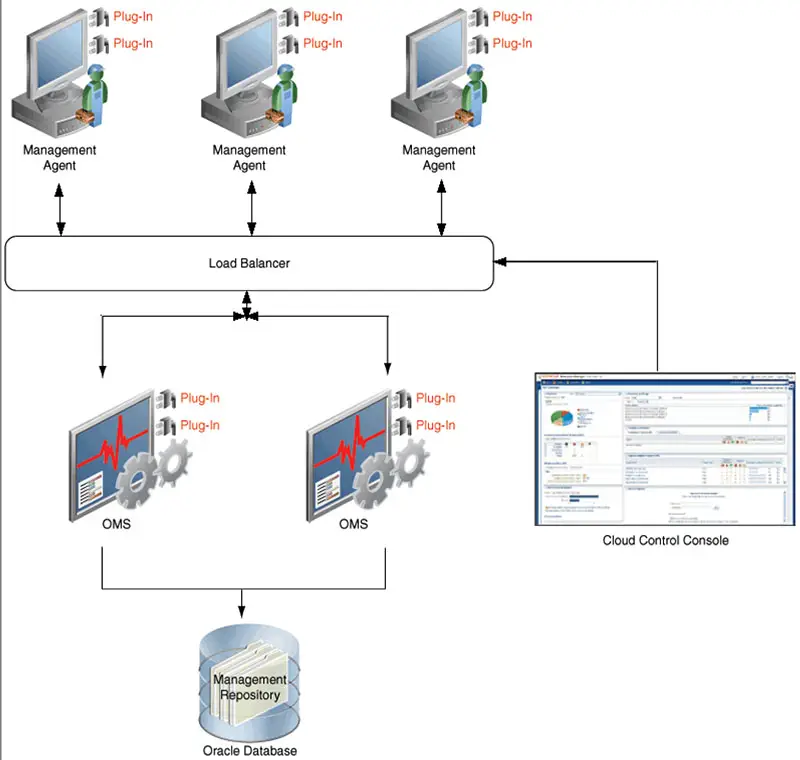| Lesson 2 | Enterprise Manager Architecture |
| Objective | Describe the architecture of Enterprise Manager. |
The DBA Management Pack
What is Enterprise Manager? To start with, Enterprise Manager is a collection of Java applications that run on your PC. Each application is designed to handle one facet of database administration. The Security Manager, for example, allows you to manage all aspects of database security. Oracle groups these applications into collections referred to as packs[1]. Most packs, such as the Oracle Tuning Pack[2], are extra cost items that must be purchased separately from Oracle. This module focuses on the DBA Management Pack that comes with Enterprise Manager, and therefore does not have to be purchased separately.
The DBA Management Pack contains five applications that allow you to perform all basic database administration functions.
The Oracle Tuning Pack, for example, consists of a set of applications that help a DBA tune an Oracle database environment.
The Oracle Tuning Pack, for example, consists of a set of applications that help a DBA tune an Oracle database environment.
Two-tier Configuration
Enterprise Manager can be installed and used in two configurations. The simplest choice, and the one we are using for this course, is a two-tier configuration. In a two-tier architecture[3], the OEM applications are run as separate programs. They run on your PC, and they connect directly to the database.
Three-tier configuration
The more complex choice is a three-tier configuration. In a three-tier environment, the applications are tied together using what is known as the Enterprise Manager Console[4]. The console allows you to monitor database events such as startup and shutdown, submit jobs to run on remote nodes, select a database to work with, and fire up the specific management applications as necessary. In order to do all this, the console communicates with an Oracle Management Server, which in turn stores information in an Enterprise Manager Repository.
The Oracle Management Server is a middle-tier application that contains all the logic for scheduling jobs, managing events, and so forth.
The repository is nothing more than an Oracle database that is used by OEM to keep track of your other Oracle databases. Information found in the repository includes information about databases that you are managing,
information about jobs that run periodically, and information about the administrators who are allowed to use Enterprise Manager.
A full-blown OEM installation will look like this:
A full-blown OEM installation will look like this:
Oracle 13c Cloud
Architecture of Enterprise Manager Cloud Control
Enterprise Manager Cloud Control includes the following components:- Oracle Management Agent
- Oracle Management Service
- Oracle Management Repository
- Plug-Ins
- Enterprise Manager Cloud Control Console

OEM Architecture
Oracle has designed Enterprise Manager as a very modular product, leaving you a lot of flexibility in how you configure it.
It is possible to use the DBA Management Pack applications individually, without benefit of the console or the Management Server. It also is possible to extend the capabilities of OEM through the installation of various add-on packages that you can buy from Oracle. Some add-ons include the Oracle Tuning Pack, the Oracle Diagnostic Pack[5], and the Oracle Change Management Pack[6].
If you want to experiment with it, a single-user, development only, version of OEM is available for free from Oracle’s technet website (technet.oracle.com). Although you cannot use it in a production setting, it is good for learning.
[1]packs: With respect to Oracle Enterprise Manager, a pack is a set of related applications that delivers functionality covering one aspect of database administration.
[2]Oracle Tuning Pack: A set of Oracle Enterprise Manager applications used for tuning an Oracle database environment.
[3]two-tier architecture: An application architecture where you have clients that communicate directly with a database server.
[4]Enterprise Manager Console: A central screen used to monitor one or more Oracle databases, and from which you can launch any of the Enterprise Manager applications.
[5]Oracle Diagnostic Pack: A set of Oracle Enterprise Manager applications used to monitor and diagnose problems in an Oracle environment.
[6]Oracle Change Management Pack: A set of Oracle Enterprise Manager applications that help the DBA plan and implement schema changes in an Oracle environment.